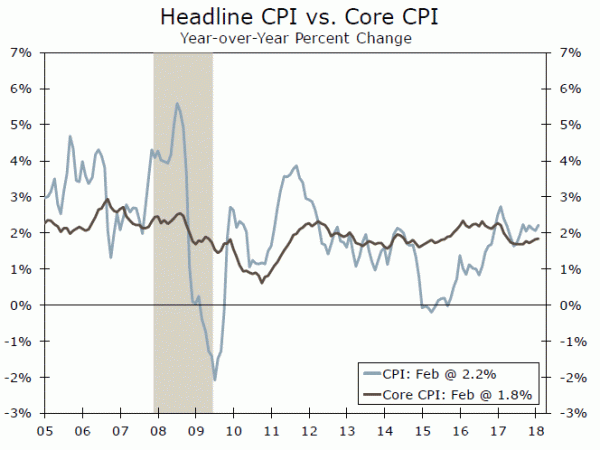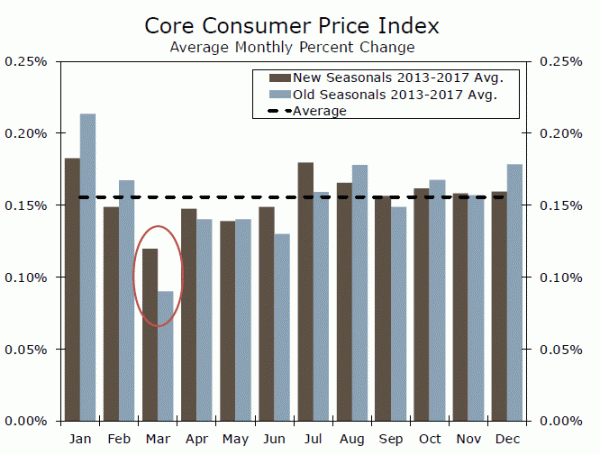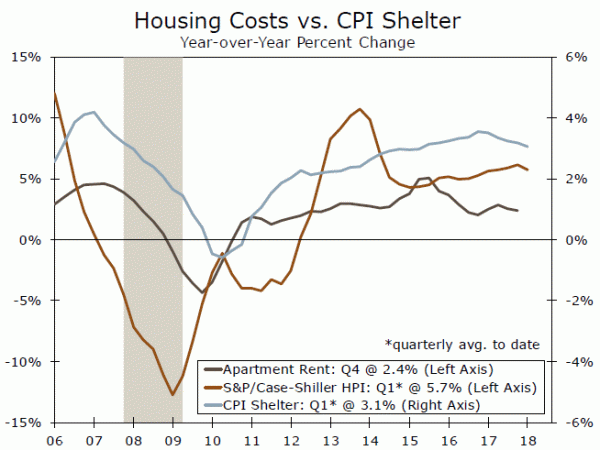CPI inflation is likely to moderate in March, with an overall gain of 0.1 percent and “low” 0.2 percent rise for core. A year after the now-infamous drop in wireless costs, core CPI should vault back above 2 percent yr/yr.
Monthly Gains to Moderate, but Year-Ago Inflation to Soar
CPI inflation has gotten off to a solid start this year. After a 0.5 percent increase in January—largely on the back of the biggest increase in core inflation in almost 12 years—there were few signs of payback in February. Both headline and core CPI rose 0.2 percent last month. The year-over-year rate of headline CPI rose to 2.2 percent, while the year-ago change in core CPI held steady at 1.8 percent.
For March, we expect monthly gains to moderate again. We forecast that headline CPI rose 0.1 percent amid an unusually small gain in energy prices for this time of year. We expect that core CPI will come in at a “low” 0.2 percent (0.15 percent), while the non-seasonally adjusted index should rise to 249.35.
The most eye-catching part of the March report is likely to be the leap in year-over-year inflation. March was the low point of last year’s inflation slowdown. Core CPI posted a rare drop (down 0.07 percent) on the back of the now-infamous decline in wireless services. That makes for an easy base comparison in March. We expect core CPI to jump to 2.1 percent on a yearago basis and for headline inflation to rise to 2.5 percent.
What We’ll Be Watching…
Cell-shock Lingers: Last year’s cell-shock may reverberate through more flattering seasonal adjustment (SA) effects this March. The latest seasonal factors now shave off less from the NSA March figures than in prior years, having taken last year’s drop as a regular change for this time of year, rather than the one-off we believe it to be (middle chart).
Core Goods—Four in a Row? The 7 percent decline in the broad trade weighted dollar since the start of 2017 has offered some modest support to core goods prices. While we expect this trend to continue, we are skeptical that core goods can string together a fourth consecutive increase. Apparel prices again looked unusually strong (up 1.5 percent after a 1.7 percent rise in January), while vehicle prices are under renewed pressure now that replacement demand following last year’s natural disasters has faded.
Shelter: Core services inflation softened in February, in part due to the smallest gains in both primary rent and owners’ equivalent rent in more than three years. While this might just be noise, we will be watching for signs that there may be more to it. Industry data show that apartment rent growth rolled over in 2016 amid a torrent of new units, but home prices have shown no such slowing as inventories remain exceptionally lean (bottom chart).
Energy: We expect that energy prices will be a slight drag this month. According to AAA, gasoline prices barely budged in March. With prices typically rising more prominently this time of year, the energy component is likely to decline after seasonal factors are applied.
















